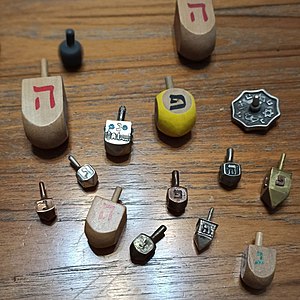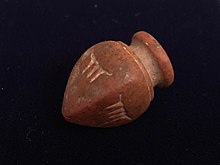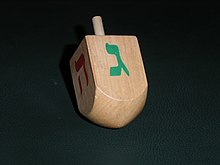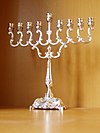

A dreidel, also dreidle or dreidl, (/ˈdreɪdəl/ DRAY-dəl; Yiddish: דרײדל, romanized: dreydl, plural: dreydlech; Hebrew: סביבון, romanized: sevivon) is a four-sided spinning top, played with during the Jewish holiday of Hanukkah. The dreidel is a Jewish variant on the teetotum, a gambling toy found in Europe and Latin America.
Each side of the dreidel bears a letter of the Hebrew alphabet: נ (nun), ג (gimel), ה (hei), ש (shin).
These letters are represented in Yiddish as a mnemonic for the rules of a gambling game possibly derived from teetotum played with a dreidel: nun stands for the word נישט (nisht, "not", meaning "nothing"), gimel for גאַנץ (gantz, "entire, whole"), hei for האַלב (halb, "half"), and shin for שטעל אַרַײן (shtel arayn, "put in"). However, according to folk etymology, they represent the Hebrew phrase נֵס גָּדוֹל הָיָה שָׁם (nes gadól hayáh sham, "a great miracle happened there"), referring to the miracle of the cruse of oil. For this reason, most dreidels in Israel replace the letter shin with the letter פ (pe), to represent the phrase נֵס גָּדוֹל הָיָה פֹּה (nes gadól hayáh poh, "a great miracle happened here"); however, many Haredi communities insist that shin be used in the Land of Israel as well, because the reference to "there" means in the Temple in Jerusalem and not in Israel.

As a result, five-sided dreidels were invented in 2022 to represent the Hebrew phase נֵס גָּדוֹל הָיָה שָׁם פֹּה (nes gadól hayáh sham poh, "a great miracle happened here and there" or "a great miracle happened everywhere"). Twenty-sided dreidels are unique as they are not spinning tops but twenty-sided dice instead.
While not mandated (a mitzvah) for Hanukkah (the only traditional mitzvot are lighting candles and saying the full hallel), spinning the dreidel is a traditional game played during the holiday.
Astronaut Jeffrey A. Hoffman spun a dreidel made by Israeli silversmith Gideon Hay for an hour in outer space.
Origins

The dreidel possibly developed from an Irish or English top introduced into Germany known as a teetotum, which was popular around Christmas time and dates back to ancient Greek and Roman times.
The teetotum was inscribed with letters denoting the Latin words for "nothing", "everything", "half", and "put in". In German this came to be called a trendel, with German letters for the same concepts. Adapted to the Hebrew alphabet when Jews adopted the game, these letters were replaced by nun which stands for the Yiddish word נישט (nisht, "not", meaning "nothing"), gimel for גאַנץ (gants, "entire, whole"), hei for האַלב (halb, "half"), and shin for שטעל אַרײַן (shtel arayn, "put in"). The letters served as a means to recalling the rules of the game.
This theory states that when the game spread to Jewish communities unfamiliar with Yiddish, the denotations of the Hebrew letters were not understood. As a result, there arose Jewish traditions to explain their assumed meaning. However, in Judaism there are often multiple explanations developed for words. A popular conjecture had it that the letters abbreviated the words נֵס גָּדוֹל הָיָה שָׁם (nes gadól hayá sham, "a great miracle happened there"), an idea that became attached to dreidels when the game entered into Hanukkah festivities.
According to a tradition first documented in 1890, the game was developed by Jews who illegally studied the Torah in seclusion as they hid, sometimes in caves, from the Seleucids under Antiochus IV. At the first sign of Seleucids approaching, their Torah scrolls would be concealed and be replaced by dreidels. The variant names goyrl (destiny) and varfl (a little throw) were also current in Yiddish, until the Holocaust. In the wake of Zionism, the dreidel was renamed sevivon (Hebrew: סביבון; from the Semetic root s-b-b, meaning 'to rotate') in modern Israel and the letters were altered, with shin generally replaced by pe. This yields the reading נֵס גָּדוֹל הָיָה פֹּה (nes gadól hayá po, "a great miracle happened here").
Etymology

The Yiddish word dreydl comes from the word dreyen ("to turn", compare to drehen, meaning the same in German). The Hebrew word sevivon comes from the Semitic root SBB ("to turn") and was invented by Itamar Ben-Avi (the son of Eliezer Ben-Yehuda) when he was five years old. Hayyim Nahman Bialik used a different word, kirkar (from the root KRKR – "to spin"), in his poems, but it was not adopted into spoken Hebrew.
In the lexicon of Ashkenazi Jews from Udmurtia and Tatarstan the local historian A. V. Altyntsev utilised several other appellations of a dreidel, such as volchok (Russian: волчок, "top"), khanuke-volchok, fargl, varfl, dzihe and zabavke (Russian: забавка, "entertaining piece", "toy").
Symbolism
Some rabbis ascribe symbolic significance to the markings on the dreidel. One commentary, for example, connects the four letters with the four nations to which the House of Judah was historically subject—Babylonia, Persia, the Seleucid Empire and Rome. A gematria reading yields the number 358, identical to the value of the four letters used to spell "Moshiach" (Messiah).
Rules of the game
Each player begins with an equal number of game pieces (usually 10–15). The game pieces can be any object, such as chocolate gelt, pennies, raisins, etc.
- To start the game, every participant puts one game piece into the center "pot". Every player also puts one piece into the pot when the pot is empty or there is only one game piece in the pot.
- Each player spins the dreidel once during their turn. Depending on which side is facing up when it stops spinning, the player whose turn it is gives or takes game pieces from the pot:
- If נ (nun) is facing up, the player does nothing.
- If ג (gimel) is facing up, the player gets everything in the pot.
- If ה (hei) is facing up, the player gets half of the pieces in the pot. If there are an odd number of pieces in the pot, the player takes half the pot rounded up to the nearest whole number. If hei is facing up and only one piece is in the pot, the player can either take the piece or not.
- If ש (shin) is facing up, the player adds one of their game pieces to the pot (sometimes accompanied by the chant "shin, shin, put one in"). In some game versions, the player adds three game pieces to the pot, one for each stem of the letter shin (ש).
- If the player is out of pieces, they are either "out" or may ask another player for a "loan".
These rules are comparable to the rules for a classic four-sided teetotum, where the letters A, D, N and T form a mnemonic for the rules of the game, aufer (take), depone (put), nihil (nothing), and totum (all). Similarly, the Hebrew letters on a dreidel may be taken as a mnemonic for the game rules in Yiddish. Occasionally, in the United States, the Hebrew letters on the dreidel form an English-language mnemonic about the rules: hei or "H" for "half"; gimel or "G" for "get all"; nun or "N" for "nothing"; and shin or "S" for "share".
Analysis of the game
Thomas Robinson and Sujith Vijay have shown that the expected number of spins in a game of dreidel is O(n), where n is the number of game pieces each player begins with. The implied constant depends on the number of players.
Robert Feinerman has shown that the game of dreidel is unfair, in that the first player to spin has a better expected outcome than the second player, and the second better than the third, and so on.
Tournaments
Dreidel is now a spoof competitive sport in North America. Major League Dreidel (MLD), founded in New York City in 2007, hosts dreidel tournaments during the holiday of Hanukkah. In MLD tournaments the player with the longest time of spin (TOS) is the winner. MLD is played on a Spinagogue, the official spinning stadium of Major League Dreidel. Pamskee was the 2007 MLD Champion. Virtual Dreidel was the 2008 MLD Champion. In 2009, Major League Dreidel launched a game version of the Spinagogue.
In 2009, Good Morning America published a story on Dreidel Renaissance reporting on the rising popularity of the dreidel. Dreidel games that have come out on the market since 2007 include No Limit Texas Dreidel, a cross between traditional dreidel and Texas Hold'em poker, invented by a Judaica company called ModernTribe. Other new dreidel games include Staccabees and Maccabees.
Collections

Childhood enjoyment of dreidels has led to a growing interest in collecting them in adulthood. Jewish institutions such as the Spertus Institute for Jewish Learning and Leadership, Yeshiva University Museum and Temple Emanu-El in New York, house dreidel collections, as do museums such as the Spinning Top and Yo-Yo Museum in Burlington, Wisconsin.

Antique dreidels are of increasing value and interest: different styles of dreidels are to be found across the world. Exemplars include dreidels fashioned in wood, silver, brass and lead. One particularly rare dreidel is cast from an ivory original by Moshe Murro from the Bezalel Academy in Jerusalem in 1929. Rare collectible dreidels from Cochin are made from iron; they are black in colour decorated with silver markings, made by an intricate Bidriware style process.
The Guinness World Record for Most Valuable Dreidel was achieved by Estate Diamond Jewelry in November 2019 and was valued at $70,000 ($83,421 in current dollars, adjusted for inflation).
The design of Estate Diamond Jewelry's dreidel was inspired by the Chrysler Building in New York. Previous holders of the title were Chabad of South Palm Beach with a dreidel valued at $14,000 ($18,019 adjusted for inflation).
See also
- "I Have a Little Dreidel" (A song sung when playing dreidel)
- Hanukkah music
- Hanukkah gelt
- Jewish ceremonial art
Notes
References
- "Definition of DREIDEL". www.merriam-webster.com. Retrieved 2021-11-27.
- "The Dreidel: More Than Just a Game". Archived from the original on 2021-01-24.
- "Treasure Trove: David Matlow explains the significance of a rare 5-sided dreidel". The Canadian Jewish News. 2023-12-10.
- "Diced dreidels". Jewish Standard. 2019-12-12.
- Brooklyn Man Wins Dreidel Spinning Contest Archived May 23, 2013, at the Wayback Machine
- Dave Gordon. "Practicing Judaism in space - Jewish astronauts reflect upon their time in outer space". Community.
- Kutzik, Jordan. "Our Favorite Hanukkah Toy Was Actually a Non-Jewish Irish Gambling Game". Archived from the original on 2017-12-15.
- ^ Rabinowitz, Dan (25 December 2005). "Chanukah Customs and sources". Archived from the original on 2017-12-22.
- ^ Rosenberg, Anat. "The Weird Ancient History of the Dreidel". Archived from the original on 19 December 2017. Retrieved 19 December 2017.
- ^ Golinkin, David. "The Surprising Origin of the Dreidel". my Jewish Learning. Archived from the original on 2017-12-13.
- ^ Pfeffer, Rabbi Yehoshua (2015-12-07). "The Chanukah Dreidel and its Halachos". dinonline.org. Archived from the original on 2017-12-22.
- ^ Common, Adiel lo/Wikimedia (9 December 2015). "Our Favorite Hanukkah Toy Was Actually a Non-Jewish Irish Gambling Game". The Forward. Retrieved 2021-11-27.
- "Dreidel Drama" (PDF). yutorah.org. Yeshiva University. Archived from the original (PDF) on December 20, 2017. Retrieved December 19, 2017.
- הירשוביץ, אברהם אליעזר בן איזיק (1918). אוצר כל מנהגי ישרון. p. 57.
- צינר, גבריאל. הלכות חנוכה - נטעי גבריאל. p. 306.
- "Chanukkah". Archived from the original on 7 January 2016. Retrieved 27 November 2015.
- Benjaminson, Chani. "What is a Dreidel?". Archived from the original on 27 November 2015. Retrieved 27 November 2015.
- "Ben Yehuda organization: Bialik". Benyehuda.org. Archived from the original on 2011-07-20. Retrieved 2011-12-23.
- Altyntsev A. V., "The Concept of Love in Ashkenazim of Udmurtia and Tatarstan", Nauka Udmurtii. 2013. № 4 (66), p. 130. (Алтынцев А.В., "Чувство любви в понимании евреев-ашкенази Удмуртии и Татарстана". Наука Удмуртии. 2013. №4. С. 130: Комментарии.) (in Russian)
- Yaakov, Rabbi. "Secret of the Dreidel". Ohr.org.il. Archived from the original on 2008-05-16. Retrieved 2011-12-23.
- "How to Play Dreidel".
- LeBon, Marilee (2001). The complete idiot's guide to holiday crafts. Alpha. p. 73. ISBN 9780028642000.
- "How to Play". my Jewish Learning. Archived from the original on 2011-12-09. Retrieved 2011-12-23.
- Robinson, Thomas; Vijay, Sujith (2006). "Dreidel Lasts O(n) spins". Advances in Applied Mathematics. 36: 85–94. doi:10.1016/j.aam.2005.05.004. S2CID 119157765.
- Feinerman, Robert (1976). "An ancient unfair game". The American Mathematical Monthly. 83 (8): 623–625. doi:10.1080/00029890.1976.11994192. JSTOR 2319887.
- "No Gelt, No Glory: A Dreidel Champion Is Crowned". NPR.org. Archived from the original on 2012-01-06. Retrieved 2011-12-23.
- "Spinagogue". Moderntribe.com. Archived from the original on 2010-03-01. Retrieved 2011-12-23.
- Milberger, Michael (2009-12-12). "Dreidel Games Generation". Abcnews.go.com. Archived from the original on 2012-01-25. Retrieved 2011-12-23.
- "No Limit Texas Dreidel". Texasdreidel.com. Archived from the original on 2011-12-08. Retrieved 2011-12-23.
- "Judaica & Jewish Gifts for Modern Jewish Living". ModernTribe. Archived from the original on 7 April 2018. Retrieved 27 April 2018.
- "Staccabees". Staccabees. Archived from the original on 2011-12-19. Retrieved 2011-12-23.
- "Battle of the Bees: Two games put a new spin on traditional dreidel game". Jweekly.com. 2009-12-03. Archived from the original on 2012-09-27. Retrieved 2011-12-23.
- ^ "Oh Dreidel, Dreidel, Dreidel: A favorite holiday pastime takes center table". Forward.com. 17 November 2010. Archived from the original on 2011-06-06. Retrieved 2011-12-23.
- "The Dreidel Museum". dreidelmuseum.com. Retrieved 2 November 2020.
- "Adelaide Dreidels". adelaidejmuseum.org.
- "Murro Dreidel". Worthpoint.
- "New York City jewelers create the world's most valuable dreidel". Guinness World Records. 2019-12-19. Retrieved 2020-01-20.
- Lubavitch, Chabad (18 November 2015). "Chabad Lubavitch Brooklyn New York NY World Headquarters". lubavitch.com. Retrieved 2020-01-20.
External links
- Dreidel Wizard
- The Origin of the Dreidel
- Computer program that plays the dreidel game (with full Java source code)
- Dreidel Design Archived 2016-03-04 at the Wayback Machine
- Types of Dreidels
- A Dreidel collection (part of world's largest collection of dice)
| ||||||||||||||||
|---|---|---|---|---|---|---|---|---|---|---|---|---|---|---|---|---|
| Traditions |
|  | ||||||||||||||
| Maccabean Revolt |
| |||||||||||||||